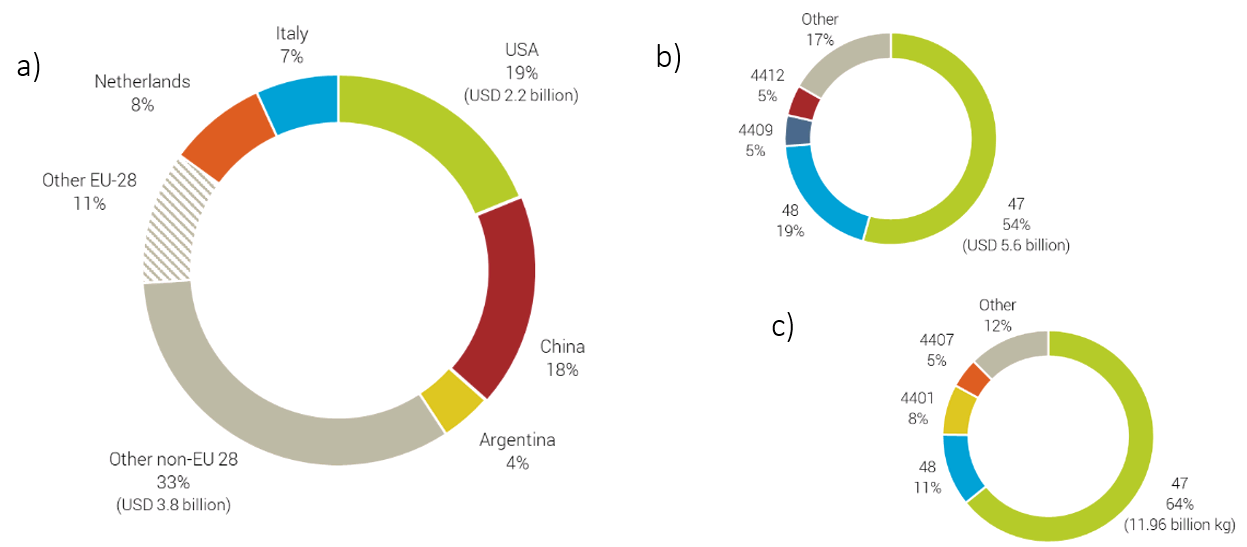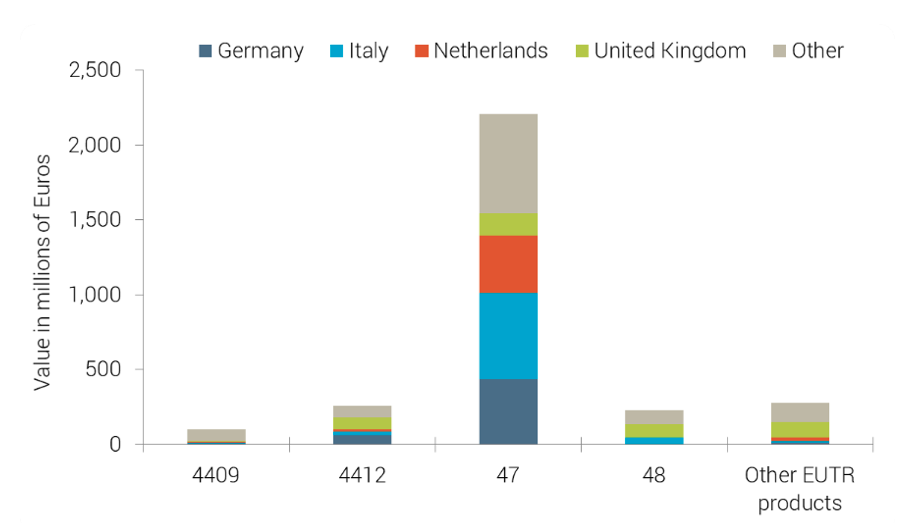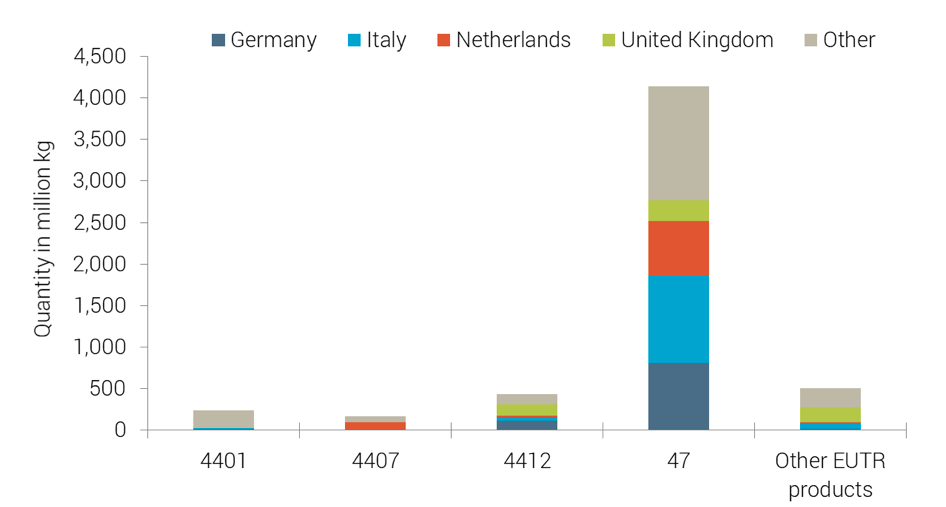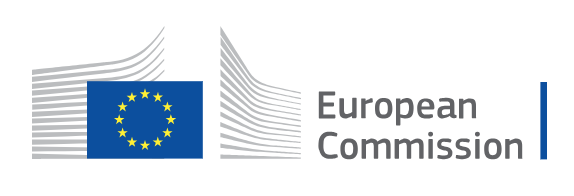LAND AREA:
FORESTED
AREA:
FOREST
TYPE:
FOREST
OWNERSHIP:
PROTECTED
AREAS:
VPA STATUS:
835.8 million hectares¹
493.5 million hectares², 59% of total land area², 7.8 million hectares of plantation³
41.1% primary²,
57.4% naturally regenerated²
46.9% state owned⁴
28% owned by local communities⁴
249.5 million hectares⁵,
42% of forests found in Protected Areas²
No VPA currently⁶
ECONOMIC VALUE OF FOREST SECTOR:
USD 22.5 billion⁷
1.1% of the GDP in 2011⁷
9th highest ranking exporter of EUTR products in
2015 by weight and value⁸
ANNUAL DEFORESTATION RATE:
4.37 million hectares of tree cover loss in natural forest in 20179
3.2 million hectares from 2013-20179
694.7 thousand hectares deforested in the Legal Amazon region in 201710
Largest net loss of forest area globally, 2010-20152
CERTIFIED FORESTS:
FSC certification: 6.7 million hectares (2018)11
PEFC certification: 3.1 million hectares (2017)12
FSC & PEFC certification: 2.5 million hectares (2016)13
CHAIN OF CUSTODY CERTIFICATION:
FSC certification: 1 031 CoC certificates (2018)¹⁰
PEFC certification: 50 CoC certificates (2017)¹¹
MAIN TIMBER SPECIES IN TRADE:
Natural forests: Garapa (Apuleia leiocarpa), sande (Brosimum utile), Spanish cedar (Cedrela odorata), freijo (Cordia goeldiana), garupa (Dinizia excelsa), tonka bean (Dipteryx odorata), cambara (Erisma uncinatum), cupiuba (Goupia glabra), Brazilian cherry (Hymenaea courbaril), macarunduba (Manilkara huberi), itauba (Mezilaurus itauba), Parkia spp., Ipe (Handroanthus serratifolia), pink ipe ( Handroanthus impetiginosa)14
Plantation: Acacia spp., Eucalyptus spp., rubberwood (Hevea brasiliensis), Pinus spp., Brazilian fern tree (Schizolobium amazonicum), teak (Tectona spp.)14
CITES-LISTED TIMBER SPECIES:
46 species: Dalbergia nigra (Appendix I), Aniba rosaeodora, Bulnesia sarmientoi, Caesalpinia echinata, Dalbergia acuta, D. amazonica, D. brasiliensis, D. catingicola, D. cearensis, D. cuiabensis, D. decipularis, D. densiflora, D. ecastaphyllum, D. elegans, D. ernest-ulei, D. foliolosa, D. foliosa, D. frutescens, D. glandulosa, D. glaucescens, D. glaziovii, D. gracilis, D. grandistipula, D. guttembergii, D. hiemalis, D. hortensis, D. hygrophilia, D. intermedia, D. inundata, D. iquitosensis, D. lateriflora, D. miscolobium, D. monetaria, D. monophylla, D. negrensis, D. revoluta, D. riedelii, D. riparia, D. sampaioana, D. spruceana, D. subcymosa, D. villosa, Swietenia macrophylla (all Appendix II), Cedrela fissilis, C. lilloi, C. odorata (all Appendix III)15
RANKINGS IN GLOBAL FREEDOM AND STABILITY INDICES:
Rule of law index16
2rd quarter
52/113 in 2017
Corruption perceptions index17
3rd quarter (score: 37)
96/180 in 2017
Fragile states index18
2nd quarter
106/178 in 2018
(Inverse scoring system)
Freedom in the world index19
2nd quarter
23/83 in 2018
LEGAL TRADE FLOWS
In 2015, Brazil exported EUTR-regulated products (timber and timber products to which the EUTR applies) to 168 countries and territories, totalling 10.3 thousand million USD, of which 26% was exported to the EU-28 (Figure 1a); the EU-28 also imported 33% by weight. Exports mainly consisted of wood pulp products (HS47*) by both weight and value, accounting for over 50% of exports by each measure (Figures 1b and 1c). Paper products (HS48) also represented a high proportion of exports. Brazil imported relatively little timber; the majority of its roundwood and sawn wood production was consumed domestically (Table 1). The majority of EUTR products imported into the EU from Brazil in 2015 were imported by Italy and Germany, followed by the Netherlands and the United Kingdom (Figures 2 and 3).

Figure 1: a) Main global markets for EUTR products from Brazil in 2015 in USD; b) main EUTR products by HS code exported from Brazil according to value in USD in 2015; and c) main EUTR products by HS code exported from Brazil by weight (kg) in 20158.
Table 1: Production and trade flows of wood products in Brazil in 201414.
| Production (x 1000 m³) |
Imports (x 1000 m³) |
Domestic consumption (x 1000 m³) |
Exports (x 1000 m³) |
|
| Logs (industrial roundwood) | 161 852 | 30 | 161 678 | 205 |
| Sawnwood | 25 510 | 40 | 24 342 | 1208 |
| Veneer | 550 | 8 | 484 | 74 |
| Plywood | 2564 | 3 | 108 | 1796 |

Figure 2: Value of EU imports of EUTR products from Brazil to the EU in 2015 by HS code. Produced using data from EUROSTAT20.

Figure 3: Quantity of EU imports of EUTR products from Brazil to the EU in 2015 by HS code. Produced using data from EUROSTAT20.
*Key to HS codes: 4401 = fuel wood; 4407 = sawn wood; 4409 = continuously shaped wood; 4412 = plywood and veneered panels; 47 = wood pulp; 48 = paper and paper products
KEY RISKS FOR ILLEGALITY
COMPLIANCE WITH LEGISLATION:
Brazil has a series of legislative acts concerning the exportation of timber (see below), but the enforcement of this legislation at state level has been inconsistent21.
BRIBERY INCIDENCE:
11.7% of firms experiencing at least one bribe payment request in 200922.
Based on data collected on behalf of the World Bank across a range of sectors.
ILLEGAL HARVESTING OF SPECIFIC TREE SPECIES:
Ipe (Handroanthus spp.)23, especially pink ipe (H. impetiginosus) and yellow ipe (H. serratifolius) [reported as Tabebuia impetiginosa, Tabebuia serratifolia24], big-leaf mahogany (Swietenia macrophylla)25.
PREVALENCE OF ILLEGAL HARVESTING OF TIMBER:
Pará State and Mato Grosso State were reported to have a 54-78% rate of illegal logging 2007-201226.
RESTRICTIONS ON TIMBER TRADE
Brazil banned export of logs in 1969 (with the exception of logs from plantations) and has a moratorium on Swietenia macrophylla exports27; logging of S. macrophylla is only permitted as part of sustainable forest management28. Logging of brazil nut trees (Bertholletia excelsa) and Hevea spp. is prohibited in natural, primary or regenerated forests29. Management of species listed a “Vulnerable” in Brazil’s “List of plant species threatened with extinction” should consider criteria laid out in Regulatory Instruction 1 of 12 Feb. 201330.
No EU31 or UN32 sanctions on timber exports or imports.
COMPLEXITY OF THE SUPPLY CHAIN
There are two source types of timber from Brazil – natural forests and plantations – the rules for the management of natural forests are more stringent, and the risks to legality of native wood are greater33
Plantation forest sourced timber make up the majority of Brazil’s exports34; 90% of plantations are owned by corporations35.
Brazil may act as a conduit for timber illegally harvested elsewhere, e.g. timber from West Africa exported to the EU via Brazil, where minor processing occurs to allow re-export as product originating in Brazil. This trade also occurs in reverse36.
Illegal trade
Brazil has a recent history of global media attention and conservation concern over the high rate of forest loss, with 18% of the Brazilian Amazon lost since a peak in deforestation in the 1980s and 1990s21. While in the late 20th century this was mainly attributed to illegal logging21, more effective enforcement brought a reduction in illegal logging in the period 2000-2010. Since 2010, illegal logging in natural forest has seen a resurgence, whilst on plantations it has remained low21. Despite this increase in illegal logging, in 2013 the main driver of forest loss was considered to be land conversion for pasture and agriculture21,37. The legal timber trade is reported to be insufficient to meet demands, meaning harvest is supplemented by the illegal trade21.
During 2000-2010, Brazil made progress on regulating the illegal trade in timber through a strong legislative framework and increased efforts to combat the illegal trade through enforcement21; both of these have been attributed to the effective implementation of the Forest Code between 2004 and 2012. In combination, legislation and enforcement were reported to have brought a significant reduction in illegal logging practices21. For example, between 2001 and 2004, the Brazilian Institute of the Environment and Renewable Natural Resources (Instituto Brasileiro do Meio Ambiente e dos Recursos Naturais Renováveis, IBAMA) increased the number of fines issued annually by 180%38.
Pará state is the greatest exporter of timber in the Brazilian Amazon, with 78% of the area logged over an 11 month period between 2011 and 2012 done so illegally26; a subsequent study of logging in Pará 2015-2016 found that 31% of management plans audited had inconsistencies, such as overestimation of species of high commercial value39. Since 2010, poor coordination, insufficient resources for enforcement, and susceptibility to fraud and laundering have all been emphasised as indicative of a downturn in the outlook for Brazilian timber23,21. This decline has in part been attributed to a change in government, which reduced the priority of policing the illegal timber trade and struggled to foster coordination between departments and agencies21. In particular, shortcomings in implementing the Action Plan for the Prevention and Control of Deforestation in the Amazon (PPCDAm), a plan drawn up in 2004 following a comprehensive review of the illegal timber trade, have been highlighted as symptomatic of the difficulties faced in inter-ministerial coordination21. The ability to regulate and monitor illegal trade has also been weakened through limited capacity and an apparent reluctance to develop bilateral agreements with consumers of illegal timber at the international level21.
A number of other issues have been highlighted as problematic in the context of the illegal timber trade and harvest in Brazil. There have been failures in payment of fines for environmental crime, with only 5% of fines imposed by the relevant authorities paid40; failures to act on evidence from satellite analyses of forest degradation; problems implementing a management system for administrative information in relation to the timber trade; and a lack of clarity on appropriate tax arrangements41. It has also been alleged that some timber plantations have been sited on illegally obtained land37.
In a 2017 risk assessment of timber legality in Brazil, NEPCon identified key risks relating to the legal rights to harvest, including: illegitimate property allocation; disputes over land inhabited by traditional communities; lack of, or low adherence to, approved management plans; and risk that forestry licenses are obtained illegally due to corruption and lack of law enforcement33. Other key risks related to tax evasion, illegal logging in protected areas, and incorrect specification of species, quantity and quality of wood products from natural forests (e.g. changing species, type of material or volume) due to a dysfunctional DOF system (see management section below) and corruption33.
Since 2014, Greenpeace has launched a series of investigations into illegal logging in the Brazilian Amazon (states of Pará, Mato Grosso and Rondonia), highlighting the inadequacy of official documentation as a guarantee of the legal origin of Amazon timber, its sustainability or that harvesting has respected the legal rights of third parties23,42,43,44. Violent conflicts over land have been reported to be a frequent occurrence in rural communities of the Brazilian Amazon, driven by illegal loggers and land grabbers43. Greenpeace noted the spatial congruence between deforestation and the location of violent crimes in the Amazon region 2007-201643, based on data from the Pastoral Land Commission (Comissão Pastoral da Terra – CPT) on murders related to land conflicts45. Illegal timber is reported to be laundered through various misuses of permits and the chain of custody (CoC) credit system (for further information on this, see below), including: issuance of logging permits for areas already logged, overestimation of the number of valuable tree species in an area to be harvested and issuance of credits for the CoC system in excess of those allowed based on the forest management plan for the area to be logged23. In 2018, researchers published evidence of a strong overestimation bias of high-value timber species’ volumes in logging permits across Pará state, compared with estimated volumes from the national forest inventory, indicating deliberate overestimation of timber volumes in logging permits across Pará state46. This ‘surplus’ of licensed timber was reported to facilitate the extraction and sale of illegal timber, and was found to be significantly greater for the most valuable timber species, such as ipê (Handroanthus spp.)44,46. The lack of field inspections was considered a key weakness in the state-level licensing process for Sustainable Forest Management Plans, facilitating illegal logging by allowing forest engineers to overestimate volumes or fraudulently add trees of high commercial value44,46. State environment departments may then issue credits for the harvesting and movement of this ‘non-existent timber’, which may be used by sawmills to process illegally logged trees from elsewhere, including indigenous lands, protected areas or public lands44,46.
Brazil has also been implicated in the laundering of illegal timber through complex trade routes. For instance, illegal teak from Peru47 and West Africa36 may be imported into the EU via Brazil, giving the impression of alternate origin. It has also been suggested that this particular trade route operates in reverse, with illegal timber harvested in Brazil sent via Africa36.
Brazil’s forestry management and legislation
The Forest Code forms the legislative basis for the enforcement of illegal timber trade activities in Brazil21. Although suggested as partly responsible for progress in the early 2000s48, more recently enforcement of the Forest Code has been described as “weak” in part due to inconsistencies at the federal and state levels21. IBAMA was responsible for enforcing the Forest Code until 2006, when authority was devolved to state environmental agencies49; however, the agreements which implemented this devolution have been described as inconsistent with regards to procedures, transparency and institutional capacity, causing inconsistencies in implementation between states49.
A system of checks and balances is implemented in Brazil, providing government accountability in the context of timber trade and its associated legislation21. The Public Prosecution Office, individuals and public groups, and civil-society organisations can all challenge the government on its record of upholding timber trade legislation21. Whilst there is no independent organisation for monitoring the forestry industry in Brazil, civil-society has been described as “active”, with numerous NGOs playing a role in monitoring the sector21. Despite these legal technicalities and efforts, mounting a legal challenge in practice has been described as “difficult”21, owing to problems in accessing the legal system for members of the public. Moreover, in cases where challenges are mounted, the public reportedly has little trust in the effectiveness of these mechanisms21.
In 2006, IBAMA introduced an electronic traceability system for timber, introducing the “Declarations of Forest Origin” (DOF) document, which contains information about timber origin, species, type of product, quantity, value and transportation route48. Implementation was subsequently devolved to state level, with different systems used in different states21; Pará and Mato Grosso currently use SISFLORA, modelled on the DOF system21. All systems are intended to allow consignments in transit to be checked against declarations made by forest producers and sawmills; however, capacity limitations mean inspections often do not occur during transit23. Combined with computer hacking, falsifications, and tampering21, there has been a “loss of confidence” in the DOF system. IBAMA recently reduced the maximum utilisation limit for log conversions in the DOF, in an effort to prevent the generation of false wood credits in the system50.
Some attempts to assess traceability and risks exist, for example Timber Flow, an online platform to allow tracing of wood production and transport through Brazilian organisations involved in the timber sector, using DOF information51.
Brazilian national law (Article 35 of law 12.651, May 2012) requires the establishment of a system to control the origin of wood, charcoal and other forestry products and by-products in order to improve traceability from harvesting to transport, storage, processing and export. As part of the implementation of this law, Brazil launched SINAFLOR52 (National System for Controlling the Origin of Forest Products) in March 201753; national states are required to integrate SINAFLOR with their current systems by January 2018. Under this provision, DOF will also be fully merged with SINAFLOR. IBAMA also makes lists of environmental infractions and embargoed areas available online54 for public access.
| RELEVANT LEGISLATION AND POLICY[1] | ||
| For further details on Brazil’s legislation relevant to EUTR, see the Brazil country page on FAOLEX and NEPCon (2017) ‘Timber legality risk assessment’. | ||
| Law 12.651 Brazil’s Forest Code (2012)
Law 12.727 amending Law No. 12.651 (2017) Action Plan for the Prevention and Control of Deforestation in the Amazon (2004) Decree No. 98.897 establishing provisions on the reserves for timber extraction (1990) Order SEMA No. 428 establishing specific guidelines for planting register and exploitation of native species planted with non-timber purposes (2014) |
Decree No. 35.439 ruling on the duty of conservation and proper management of private forests established by forest products’ consumers (1994)
Order No. 24 establishing auction requirements for selling seized forest products (1994) Order No. 315-P regulating forest exploitation (1984) Order No. 13-N regulating logged tree exportation system (1993) Order No. 74-N establishing tree logging plan in reforested areas (1992) |
|
| LEGALLY REQUIRED DOCUMENTS[2] | ||
| See NEPCon (2017) ‘Timber legality risk assessment’ for a further list of legally required documents. | ||
| Planting licenses (forest managers and harvesting companies require licenses before planting an exotic species forest)
Concession contract AUTEF/AUTEX (Authorization of Forest Exploitation) Sustainable Forest Management Plan (Plano de Manejo Florestal Sustentável – PMFS) Annual Operational Plan (Plano Operacional Anual – POA). Licença de operação (Operating Authorisation) Land title documents (when harvesting from private lands land owners must hold land title documents) Deforestation authorisation (document authorising timber harvest from converted lands on native forests) Forest Voucher (for native species from plantations) |
DOF/Guia Florestal (Document of Forest Origin: a computerised timber control system with information on origin, species, product type, quantity, and cargo value)
Alvará (Municipal operating licence for industry) Nota Fiscal de Compra/Venda do Producto (Log bill of sales/Invoice) Certidão negativa da receita federal (Clearance Certificate for general fees and taxes of company activities) For Exports:
|
|
[1] The following list may not be exhaustive and is intended as a guide only on relevant legislation.
[2] The following list may not be exhaustive and is intended as a guide only on required documents.
References
- FAO. FAO Country Profiles: Brazil. (2018). Available at: http://www.fao.org/countryprofiles/index/en/?iso3=BRA. (Accessed: 2nd July 2018)
- FAO. Global Forest Resources Assessment 2015. Desk reference. (Food and Agriculture Organization of the United Nations, 2015).
- IBÁ. Relatório Anual. (Indústria Brasileira de Árvores, 2017). doi:10.1017/CBO9781107415324.004
- Rights and Resources Initiative. Tenure data tool. (2018). Available at: https://rightsandresources.org/en/work-impact/tenure-data-tool/#.WjjlOVVl9ph. (Accessed: 2nd July 2018)
- UNEP-WCMC. Protected Area Profile for Brazil from the World Database of Protected Areas. (2018). Available at: https://www.protectedplanet.net/country/BR. (Accessed: 2nd July 2018)
- EU FLEGT Facility. VPA countries. (2018). Available at: http://www.euflegt.efi.int/vpa-countries. (Accessed: 2nd July 2018)
- FAO. Contribution of the forestry sector to national economies, 1990-2011, by A. Lebedys and Y. Li. Forest Finance Working Paper FSFM/ACC/09 (Food and Agricultural Organization of the United Nations, 2014).
- United Nations Statistics Division. UN Comtrade Database. (2017). Available at: https://comtrade.un.org/data/.
- Global Forest Watch. Brazil Country Profile. (2018). Available at: http://www.globalforestwatch.org/country/BRA. (Accessed: 2nd July 2018)
- INPE & MCTI. PRODES project: monitoring of the Brazilian Amazonian forest by satellite. (2018). Available at: http://www.obt.inpe.br/OBT/assuntos/programas/amazonia/prodes. (Accessed: 29th September 2018)
- FSC. Facts and figures August 2018. (Forest Stewardship Council, 2018).
- PEFC International. PEFC global statistics SFM & CoC certification. (2017).
- FSC & PEFC. Estimated total global double certified area FSC/PEFC. (FSC and PEFC, 2017).
- European Timber Trade Federation. Brazil Industry Profile. Gateway to International Timber Trade (2018). Available at: http://www.timbertradeportal.com/countries/brazil/. (Accessed: 2nd July 2018)
- UNEP-WCMC. The Species+ Website. Nairobi, Kenya. Compiled by UNEP-WCMC, Cambridge, UK. (2018). Available at: https://speciesplus.net/. (Accessed: 2nd July 2018)
- World Justice Project. Rule of Law Index 2017-2018. (2018). Available at: http://data.worldjusticeproject.org/. (Accessed: 2nd July 2018)
- Transparency International. Corruption Perceptions Index 2017. (2018). Available at: https://www.transparency.org/news/feature/corruption_perceptions_index_2017. (Accessed: 2nd July 2018)
- Fund for Peace. Fragile States Index 2018. (2018). Available at: http://fundforpeace.org/fsi/. (Accessed: 2nd July 2018)
- Freedom House. Freedom in the World. (2018). Available at: https://freedomhouse.org/report/freedom-world-2018-table-country-scores. (Accessed: 2nd July 2018)
- European Commission. Eurostat. (2018). Available at: http://ec.europa.eu/eurostat/data/database. (Accessed: 2nd July 2018)
- Wellesley, L. Illegal logging and related trade: the response in Brazil. (Chatham House, 2014).
- The World Bank. Bribery incidence (% of firms experiencing at least one bribe payment request). (2017). Available at: https://data.worldbank.org/indicator/IC.FRM.BRIB.ZS.
- Greenpeace. The Amazon’s silent crisis. (Greenpeace, 2014).
- Schulze, M., Grogan, J., Uhl, C., Lentini, M. & Vidal, E. Evaluating ipe (Tabebuia, Bignoniaceae) logging in Amazonia: Sustainable management or catalyst for forest degradation? Biol. Conserv. 141, 2071–2085 (2008).
- Grogan, J. & Barreto, P. Big-leaf mahogany on CITES appendix II: Big challenge, big opportunity. Conserv. Biol. 19, 973–976 (2005).
- Monteiro, A.; Cardoso, D.; Conrado, D.; Verissimo, A., Souza Jr, C. Forest Management Transparency Report – State of Pará (2012 to 2013). In: Greenpeace. The Amazon’s silent crisis. (Greenpeace, 2014). (Imazon, 2013).
- Forest Legality Initiative. Logging and export bans. (2017). Available at: http://www.forestlegality.org/content/logging-and-export-bans. (Accessed: 26th April 2017)
- Presidência da República do Brasil. Decreto No 6.472 de 5 de Junho de 2006. (Presidência da República do Brasil, 2008).
- Presidência da República do Brasil. Decreto No 5.975 de 30 de Novembro de 2006. (Presidência da República do Brasil, 2006).
- Ministério do Meio Ambiente. Instrução Normativa No – 1, De 12 De Fevereiro De 2015. (Diário Oficial da União – Seção 1, 2015).
- European Commission. European Union: restrictive measures (sanctions) in force. Updated 4.8.2017. (European Commission, 2017).
- United Nations Security Council. Consolidated United Nations Security Council Sanctions List 27 November 2017. (United Nations Security Council, 2017).
- NEPCon. Timber legality risk assessment – Brazil. Version 1.1. (2017).
- TRAFFIC. FLEGT Brazil briefing document. (TRAFFIC, 2012).
- Kröger, M. Contentious Agency and Natural Resource Politics. (Routledge, 2014).
- Bisschop, L. Out of the woods: the illegal trade in tropical timber and a European trade hub. Glob. Crime 13, 191–212 (2012).
- Lawson, S. et al. Consumer goods and deforestation: an analysis of the extent and nature of illegality in forest conversion for agriculture and timber plantations. (Forest Trends, 2014).
- Brito, B. & Barreto, P. in Compliance and Enforcement in Environmental Law. Towards more effective implementation (ed. Paddock, L.) 297–310 (Edward Elgard Publishing, 2011).
- Cardoso, D. & Souza Jr., C. Sistema de Monitoramento da Exploração Madeireira (Simex). (Imazon, 2017).
- Barreto, P., Araújo, E. & Brito, B. A impunidade de crimes ambientais em áreas protegidas federais na Amazônia. (IMAZON, 2009).
- De Cássia Carmélio, E. Fortalecimento do Setor Florestal no Brasil: Mapeamento da carga tributária incidente sobre os produtos florestais madeireiros e proposição de medidas de desoneração. (Serviço Florestal Brasileiro, 2013).
- Greenpeace. The Amazon’s silent crisis: night terrors. (Greenpeace Brazil, 2014).
- Greenpeace. Blood-stained timber: rural violence and the theft of Amazon timber. (Greenpeace Brazil, 2017).
- Greenpeace. Imaginary trees, real destruction: how licensing fraud and illegal logging of Ipe trees are causing irreversible damage to the Amazon rainforest. (Greenpeace Brazil, 2018).
- Comissão Pastoral da Terra. Conflitos no Campo Brasil 1985-2016. (2017). Available at: https://www.cptnacional.org.br/component/jdownloads/download/41-conflitos-no-campo-brasil-publicacao/266-conflitos-no-campo-brasil-1985.
- Brancalion, P. H. S. et al. Fake legal logging in the Brazilian Amazon. Sci. Adv. 4, (2018).
- EIA. The laundering machine: how fraud and corruption in Peru’s concession system are destroying the future of its forests. (EIA, 2012).
- TFT. Country Guide To Timber Legality: Brazil. (The Forest Trust, 2013).
- May, P. Forest Certification in Brazil. (Yale School of Forestry and Environmental Studies, 2004).
- IBAMA. Novo índice de aproveitamento para transformação de tora em madeira serrada combate desmatamento ilegal. (2017). Available at: http://www.ibama.gov.br/noticias/422-2017/1092-novo-indice-de-aproveitamento-para-transformacao-de-tora-em-madeira-serrada-combate-desmatamento-ilegal. (Accessed: 2nd June 2017)
- Imaflora. Timber Flow. (2018). Available at: http://timberflow.org.br/. (Accessed: 31st January 2018)
- IBAMA. Sistema Nacional de Controle da Origem de Produtos Florestais (Sinaflor). (2017). Available at: https://servicos.ibama.gov.br/index.php/licencas/sistema-nacional-de-controle-da-origem-de-produtos-florestais-sinaflor. (Accessed: 31st January 2018)
- IBAMA. Ibama e MMA lançam sistema nacional de controle florestal. (2017). Available at: http://www.ibama.gov.br/noticias/422-2017/1019-ibama-e-mma-lancam-sistema-de-controle-florestal. (Accessed: 31st January 2018)
- IBAMA. Consulta a Embargos e Autos de Infração. (2017). Available at: https://servicos.ibama.gov.br/ctf/publico/areasembargadas/ConsultaPublicaAreasEmbargadas.php.


